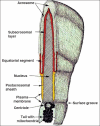Perspective on plasma membrane cholesterol efflux and spermatozoal function
- PMID: 21209749
- PMCID: PMC2970794
- DOI: 10.4103/0974-1208.69337
Perspective on plasma membrane cholesterol efflux and spermatozoal function
Abstract
The process of sperm maturation, capacitation, and fertilization occur in different molecular milieu provided by epididymis and female reproductive tract including oviduct. The different tissue environment with different oxygen tension and temperature may still influence the process of sperm maturation and capacitation. Reactive oxygen species (ROS) is reported to be an initial switch that may activate the molecular process of capacitation. Therefore, the generation of reactive oxygen species and its possible physiological role depends upon a balance between its formation and degradation in an open environment provided by female reproductive tract. The sensitivity of the spermatozoa to the action of ROS may be due to its exposure for the first time to an oxygen rich external milieu compared to its internal milieu in the male reproductive tract. Reduced temperature in testicular environment coupled with reduced oxygen tension may be the right molecular environment for the process of spermatogenesis and spermiogenesis. The morphologically mature spermatozoa then may attain its motility in an environment provided by the caput epididymis wherein, the dyenin motor can become active. This ability to move forward will make the spermatozoa physiologically fit to undertake its sojourn in the competitive race of fertilization in a new oxygen rich female reproductive tract. The first encounter may be oxygen trigger or preconditioning of the spermatozoa with reactive oxygen species that may alter the spermatozoal function. Infertility is still one of the major global health problems that need medical attention. Apart from the development of artificial methods of reproduction and development of newer techniques in the field of andrology focuses attention on spermatozoal structure and metabolism. Therefore, understanding the molecular mechanisms involved in fertilization in general and that of sperm capacitation in particular may help lead to new and better techniques for enhancing fertility, identifying and treating certain forms of male infertility, and preventing conception. One remarkable insight is the importance of membrane cholesterol efflux in initiating transmembrane signaling events that confer fertilization competence. The identity of the physiologically relevant cholesterol acceptors and modulators of cholesterol efflux is therefore of great interest. Still, it is clear that cholesterol efflux represents only a part of this story. The involvement of phospholipid translocation in mediating dynamic changes in the membrane, rendering it conducive to transmembrane signaling, and the modulation of membrane components of signal transduction cascades by cholesterol or phospholipids will yield important insights into the links between environmental sensing and transmembrane signaling in the sperm. Understanding the membrane molecular events will ultimately provide new and exciting areas of investigation for the future.
Keywords: Capacitation; cholesterol; phospholipid; transmembrane signaling.
Conflict of interest statement
Figures





References
-
- Austin CR. The capacitation of the mammalian sperm. Nature. 1952;170:326. - PubMed
-
- Chang MC. Fertilizing capacity of spermatozoa deposited into the fallopian tubes. Nature. 1951;168:697–8. - PubMed
-
- Wassarman PM. Mammalian fertilization: Molecular aspects of gamete adhesion, exocytosis, and fusion. Cell. 1999;96:175–83. - PubMed
-
- Kopf GS. Signal transduction mechanisms regulating sperm acrosomal exocytosis. In: Hardy DM, editor. Fertilization. San Diego, California, USA: Academic Press Inc; 2002. pp. 181–223.
-
- Quill TA, Garbers DL. Sperm motility activation and chemo attraction. In: Hardy DM, editor. Fertilization. San Diego, California, USA: Academic Press Inc; 2002. pp. 29–55.
LinkOut - more resources
Full Text Sources
